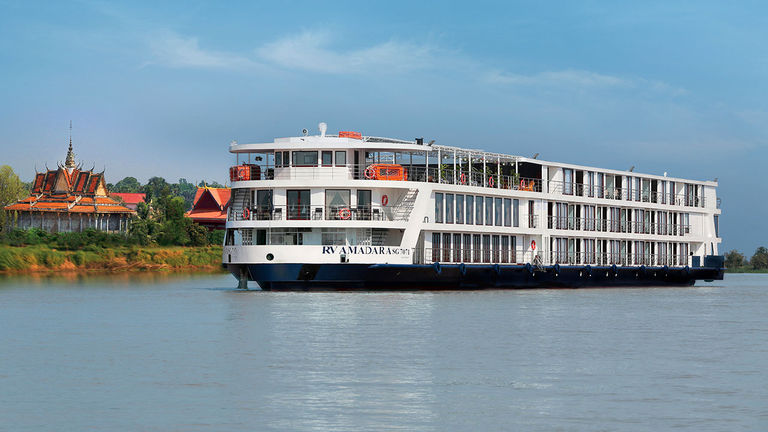The mesmerizing chanting of Buddhist monks resounded through the grand temple at Cambodia’s Oudong monastery as they bestowed a traditional blessing on our AmaWaterways cruise group. The experience felt especially meaningful given that the monks had chatted with us beforehand (in perfect English) about their daily lives, their role in Cambodian society and the blessings they confer.
This was one of more than a dozen cultural encounters curated for our seven-night Mekong River cruise. Whether participating in home and school visits in rural villages, touring workshops where local products are made or strolling through a wet market, our engaging Vietnamese and Cambodian guides prepared us to be respectful of local customs. Their personal stories and insights also helped us make sense of all we were seeing.
We also hiked and boated in the Tra Su Cajuput Forest and Bird Sanctuary (which preserves a habitat once common in the Mekong) on a recently added excursion option. Traveling silently by boat through narrow waterways bordered by towering cajuput trees was a magical experience. Also unforgettable was a guided walk through Angkor Ban, a small agricultural village where we were warmly welcomed into the home of an older couple.
AmaWaterways has been continually evolving its ports and programming since it began cruising the Mekong in 2009, adding increasingly in-depth cultural, historic and active excursions. Partnering with local communities and experts ensures its operations positively impact both the environment and the local communities — a growing priority that is especially important to younger generations.
Onboard AmaDara
I was traveling with my 30-something daughter, and we were delighted to find another mother-daughter pair and several adventurous young couples whose previous Asia trips had involved trekking and staying at hostels. We all appreciated being able to get off the beaten path while, at the end of each outing, returning to our air-conditioned, sumptuous traveling “home” — the 124-passenger AmaDara.
 AmaDara’s design details reflect the Mekong’s local culture and influences.
AmaDara’s design details reflect the Mekong’s local culture and influences.
Credit: 2025 AmaWaterwaysEven AmaDara felt connected to the places we visited. Built in Ho Chi Minh City, Vietnam, with local materials, it reflects the region’s Asian and French Colonial influences with delightful touches, such as an antique-style phone, wood furnishings and rattan accents that made even the hallways an aesthetic experience.
Having an almost fully local service staff further immersed us in the Mekong’s culture. An impressive schedule of wellness classes drew on yoga, tai chi, qigong and other disciplines, attracting a regular group of participants. There was also a small fitness room, a plunge pool and excellent massages on offer.
There were regional options at every meal, starting with pho (soup) for breakfast, along with excellent international fare. Plus, everyone was invited to enjoy an elegantly served tasting menu at The Chef’s Table restaurant.
Cabins had both outside and French balconies and ample storage. We loved the paintings of local scenes found around the ship and available for sale at the small onboard boutique, which had a surprising selection of clothing and crafts.
Guests socialized at the outdoor sun deck lounge and the indoor Saigon Lounge, which hosted regional music and dance performances, cultural lectures and cooking and tea demonstrations. A live pianist drew a dedicated crowd in the evenings.
A second ship, AmaMaya, is slated to begin Mekong sailings in August 2026. The program is expected to remain the same, though I’m told that the details are still being sorted out.
This was my daughter’s first river cruise, but it won’t be her last. She’s already asking me to plan a mother-daughter trip to Colombia when AmaWaterways starts cruising there this year.